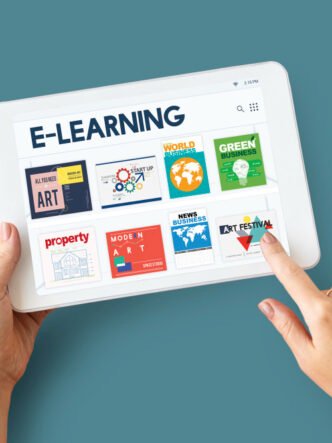The way end-users receive visual content has drastically improved over the years and this change impacts almost all sectors.

OTT technology is one of the latest strides that have been made in this regard and it has impacted industries like the entertainment sector all the way to EdTech.
Since EdTech has become so reliant on videos to train and pass instruction, OTT platforms have become prevalent in this industry as well. OTT video platform has had an immense impact on online learning, and online course developers should have a positive outlook on disruptive technologies like OTT.
What are OTT platforms, how do they impact the e-learning industry and how can you share your online course content using them?
What is OTT Platform? Why should OTT matter for online courses?

At first, video content was solely shared through cable and satellite service providers due to the convenience of using an established reliable infrastructure.
With internet protocol technology advancing, it has become easier and more economical to share visual and video content on the web.
Faster internet connections and easier video encoding and decoding protocols have brought OTT platforms to reality.
Over-the-top platforms (OTT) are media service providers that use public internet protocols instead of closed private networks with proprietary equipment such as set-top boxes.
OTT platforms can be used to stream live video or recorded programs and even download them to a local drive. Instead of using a multiple-system operator technology, OTT serves as a vehicle transporting video content in IP packets as a third party.
As a result, you can retain the copyright, viewing abilities, and the rights to redistribute the video content when uploading it.
An OTT platform is a great solution for online courses since there are minimal legal hoops to jump through when using it.
As the online course developer, you retain the copyrights and ownership of the video content instead of signing it over to a redistributing media company.
Using OTT technology, online course developers have all the latitude they need to edit their video content and update it according to the latest industry landscape.
OTT media affords digital content creators the freedom to customize their content and delivery method at an unimaginable rate. User satisfaction can also be easily met since OTT itself can be customized to end-user preferences.
The learning experience thus becomes much beneficial to the audience being catered for.
4 Benefits of creating an online courses OTT Platform

Online courses have developed great momentum in the EdTech industry but they can still be taken a step further through the development of OTT platforms for e-learning.
When developed competitively using the right technologies, such as a cutting-edge hosting provider, these platforms can improve the performance of online courses.
There are several benefits to using OTT video platforms to distribute online course content.
Here are four main advantages related to implementing this technology:
- Video for all device/screens
- Create a distinct Netflix-like Online Course Channel with OTT
- Let viewers choose from where to consume the online course video content
- Video Analytics from one platform
1. Video for all devices/Screens
The main beauty of an ott video platform is that it can be developed to have a cross-platform video interface suitable for any type of device, be it smart tv, laptop or mobile.
This kind of video distribution platform utilizes modern technologies that allow web apps and native applications to be responsive and fit into any screen size. Therefore, the video content can be uploaded once to the platform and can be reused on a cross-platform interface.
By extension, this relieves the pressure of editing one video multiple times to make it fit into different screen sizes.
OTT platforms use a standard video format and aspect ratio on mobile devices and desktops. Users can access the online course material from anywhere, even in transit.
The students subscribed to the course can have more flexibility on how and when to consume your online course content.
A relaxed environment afforded by OTT app like this can lead to quicker learning as the course will be easily accessible on any device that has an internet connection.
At the same time, video creation and publishing are also simplified for course developers to fit a unified omnichannel standard.
Developing countries can also utilize cross-platform OTT platforms since, in some regions, the majority of the population only has access to mobile devices.
Instead of focusing on desktop usability only, a responsive web app or native mobile application can solve e-learning crises in developing countries.
As a course developer, you can gain access to a wider target audience, widening your footprint globally in the courses you’re developing with the advanced technology of OTT video platform.
2. Create a distinct Netflix-like Online Course Channel with OTT

Users expect an immersive experience when consuming video content, similar to what Netflix has offered in the entertainment industry.
When users log in to Netflix, they feel secluded and immersed in this “digital” cinema.
When sharing online video course content, it is equally important to immerse the user in this virtual classroom environment you have created.
Making the OTT course platform distinct can help facilitate the needs of students that have varying learning styles.
Categorizing the online course videos through different criteria and suggesting related content through personalization can help improve the learning curve of each user.
Constantly improving the user interface and customer experience on the platform by upgrading responsiveness and gesture control will also play a huge role in fulfilling that.
Having new video content to share on each course you are regularly offering will also mark your OTT platform as unique and positively impact academic performance.
OTT platforms can also be developed to have features such as cross-platform app interfaces, just as Netflix does.
Additionally, you can design the OTT platform to be a subscription-based service with customizable access control. Users can have a public section with no paywall and a login page that is subscription-based with exclusive course content.
As the course developer, you can license all the videos under your copyright on the platform to avoid any legal disputes. That would be similar to what Netflix has done to most movies and television shows broadcasted on their platform.
3. Let Viewers choose from where to consume the online course video content – Smart TV, Laptop, Mobile or Desktop

User preferences differ even when dealing with online video course material.
The preferences range across a wide spectrum of options. This includes the type of video content they consume, the categories they’re under and even third-party platforms the videos may be sourced from.
Some platforms might be utilizing a variety of third-party hosting servers or even other OTT platforms integrated onto the platform. If you use multiple hosting servers, allowing users to choose which server to use can improve the user experience.
Personalizing user preference is one of the great benefits of developing an OTT platform for online courses instead of using other distribution channels.
Viewers can have a say on the source of the content they consume if your platform utilizes multiple servers.
At the same time, a custom OTT platform that has categorized videos in accordance with relevant filters also gives users the freedom to choose the type of content they consume.
The options presented to users can provide a seamless experience that awards viewers the freedom to quickly find the content they need at that time.
If you have integrated third-party video platforms like YouTube or other OTT streaming service providers, allowing users to choose which platform to use can help improve the user experience.
When users choose between the integrated third-party video platforms on your OTT service, they can pick a quick service with the least buffering time on videos.
Developing your own OTT platform can possess this major benefit of allowing users to choose which third-party source or even internal category to use when accessing online course videos.
4. Video Analytics from one platform
Using an OTT platform to share online video course content comes with other benefits for course developers.
Instead of implementing complex software that aggregates insights from multiple sources, you can gather the analytical data from a central point. Such complexities can be incurred when online video content is scattered across other third-party platforms.
Even when the video content is being embedded on an online learning site through third-party platforms, gathering and aggregating analytical insights can be relatively challenging.
The problem is simplified when all relevant insights are gathered from a single source. In this case, only one comprehensive video analytical dashboard can be used to gauge the platform’s performance.
Other analytical insights gathered on a centralized data source, namely your OTT platform, including user preferences and habits.
You can understand the habits of your users and how to improve the service being provided to them through the OTT platform you’ve developed. These key performance indicators and others can be used to compile reports over a period of time such as quarters, biannual or annual timeframes.
Those video analytics reports will help upgrade and improve the level of service being provided to end-users. On the other hand, online course developers have the option of accessing real-time video analytical insights from the video platform.
With these insights, course developers will have the data needed to make agile tactical business decisions in real-time. All the insights gathered from your OTT solution may be filtered according to the type of report and action that needs to be taken.
Cast and Stream your online course on Roku TV, Samsung TV & Apple TV

Smart TVs are being globally used to view content on entertainment OTT platforms such as Netflix, Hulu, and YouTube.
When users access the OTT platform using Google Chrome, casting their screen becomes much easier through the Chromecast feature.
Your online course videos can also be accessed using the same method and cast on a smart TV such as Roku, Samsung, or Apple TV. This can immerse students in the course videos being cast onto the Smart TV at that time.
The learning experience will be ultimately improved and students will have a better understanding of the subjects being explored.
At the same time, students might even have the opportunity to watch the course videos in 3D if their Smart TVs allow them to.
Learning can be much fun for students using an OTT platform that can be cast and streamed on a Smart TV.
Developing the platform in a manner friendly for casting and streaming on TV will contribute to a better user experience.
To develop a stream casting-friendly OTT solution, course developers much ensure that features such as full-screen mode are immersive and have minimal distractions.
That might mean shortening captions and auto-hiding them when in full-screen mode to give users the experience they are looking for.
When using this platform, viewers must feel like they are watching TV instead of a desktop or mobile device screen. After all, it’s all about the experience you provide to your audience that engages them and brings them back to your content repeatedly.
OTT video platform: Doorway to capturing a larger audience for your online course

Developing an OTT video platform for your online course is a doorway to capturing a larger audience. A dedicated platform to share educational video content in an organized and properly categorized way can make the courses you have developed easier to market.
At the same time, an OTT solution has the potential to tap into a global audience as long as the courses are standardized to share content in a globally competent way.
Instead of directing people to third-party platforms which might have their challenges on some devices or geographical locations, having an exclusive OTT platform emanates a strong brand image.
This marks the services you are providing as exclusive and personalized when compared with competing service providers.
More customers might sign up for the video courses offered on the OTT platform and above your marketing efforts, students might create promotional user-generated content and word-of-mouth recommendations.
Developing an OTT platform with all the latest features and videos that are regularly updated can reach a wider audience for your online.
Conducting competitor analysis across the OTT industry is another important step to capturing a larger audience within the EdTech industry.
Continually improving the OTT platform to be up to par with the latest tech trends implemented by OTT giants like Netflix, Hulu, etc., should be the goal of all online course developers.









